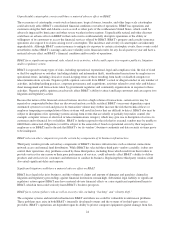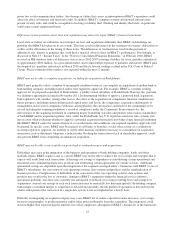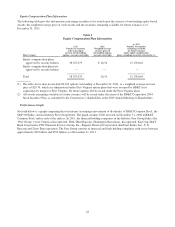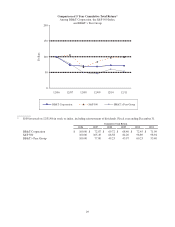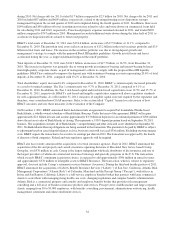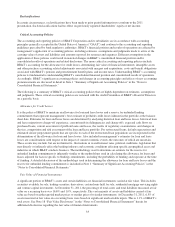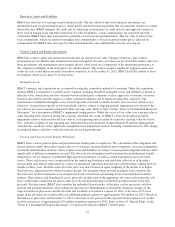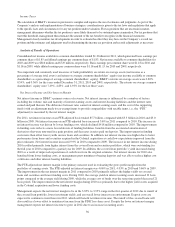BB&T 2011 Annual Report Download - page 34
Download and view the complete annual report
Please find page 34 of the 2011 BB&T annual report below. You can navigate through the pages in the report by either clicking on the pages listed below, or by using the keyword search tool below to find specific information within the annual report.
Securities
The fair values for available-for-sale and trading securities are generally based upon observable market prices for similar
instruments or quoted market prices. BB&T generally utilizes a third-party pricing service in determining the fair value of
its securities portfolio. The pricing service uses observable inputs when available including benchmark yields, reported
trades, broker-dealer quotes, issuer spreads, benchmark securities, bids and offers. These values take into account recent
market activity as well as other market observable data such as interest rate, spread and prepayment information.
Management performs various procedures to evaluate the accuracy of the fair values provided by the third-party service.
These procedures include back-testing to compare the price realized on security sales to the daily pricing information
received from the third party pricing service, comparison of a sample of pricing information received from the third party
pricing service to other third party pricing sources, and review of additional information provided by the third party
pricing service for selected securities. When market observable data is not available, which generally occurs due to the
lack of liquidity for certain securities, the valuation of the security is subjective and may involve substantial judgment by
management. As of December 31, 2011, BB&T had approximately $984 million of available-for-sale securities, which is
less than 1% of total assets, valued using unobservable inputs. This total is almost entirely non-agency mortgage-backed
securities that are covered by a loss sharing agreement with the FDIC.
BB&T periodically reviews available-for-sale securities with an unrealized loss. An unrealized loss exists when the
current fair value of an individual security is less than its amortized cost basis. The purpose of the review is to consider
the length of time and the extent to which the market value of a security has been below its amortized cost. The primary
factors BB&T considers in determining whether an impairment is other-than-temporary are long-term expectations and
recent experience regarding principal and interest payments, and BB&T’s intent to sell and whether it is more likely than
not that the Company would be required to sell those securities before the anticipated recovery of the amortized cost basis.
Mortgage Servicing Rights
BB&T has a significant mortgage loan servicing portfolio and related mortgage servicing rights (“MSRs”). BB&T has
two primary classes of MSRs for which it separately manages the economic risk: residential and commercial. Residential
MSRs are primarily carried at fair value with changes in fair value recorded as a component of mortgage banking income
each period. BB&T uses various derivative instruments to mitigate the income statement effect of changes in fair value,
due to changes in valuation inputs and assumptions, of its residential MSRs. MSRs do not trade in an active, open market
with readily observable prices. While sales of MSRs do occur, the precise terms and conditions typically are not readily
available. Accordingly, BB&T estimates the fair value of residential MSRs using an option adjusted spread (“OAS”)
valuation model to project MSR cash flows over multiple interest rate scenarios, which are then discounted at risk-
adjusted rates. The OAS model considers portfolio characteristics, contractually specified servicing fees, prepayment
assumptions, delinquency rates, late charges, other ancillary revenue, costs to service and other economic factors. BB&T
reassesses and periodically adjusts the underlying inputs and assumptions in the OAS model to reflect market conditions
and assumptions that a market participant would consider in valuing the MSR asset. When available, fair value estimates
and assumptions are compared to observable market data and to recent market activity and actual portfolio experience.
Due to the nature of the valuation inputs, MSRs are classified within Level 3 of the valuation hierarchy. The value of
MSRs is significantly affected by mortgage interest rates available in the marketplace, which influence mortgage loan
prepayment speeds. In general, during periods of declining interest rates, the value of MSRs declines due to increasing
prepayments attributable to increased mortgage-refinance activity. Conversely, during periods of rising interest rates, the
value of MSRs generally increases due to reduced refinance activity. Commercial MSRs are carried at the lower of cost or
market and amortized over the estimated period that servicing income is expected to be received based on projections of
the amount and timing of estimated future cash flows. The amount and timing of servicing asset amortization is based on
actual results and updated projections. In addition, BB&T has approximately $14 million of residential MSRs that are
valued at the lower of cost or market. These MSRs are associated with government sponsored programs that have
prepayment assumptions that are difficult to model, which make it difficult to hedge the associated risk. Refer to Note 7
“Loan Servicing” in the “Notes to Consolidated Financial Statements” for quantitative disclosures reflecting the effect that
changes in management’s assumptions would have on the fair value of MSRs.
Loans Held for Sale
BB&T originates certain mortgage loans to be sold to investors that are carried at fair value. The fair value is primarily
based on quoted market prices for securities backed by similar types of loans. Changes in the fair value are recorded as a
component of mortgage banking income while mortgage loan origination costs for loans held for sale for which the
Corporation elected the Fair Value Option are recognized in noninterest expense when incurred. The changes in fair value
of these assets are largely driven by changes in interest rates subsequent to loan funding and changes in the fair value of
servicing associated with the mortgage loan held for sale. BB&T uses various derivative instruments to mitigate the
economic effect of changes in fair value of the underlying loans.
34


